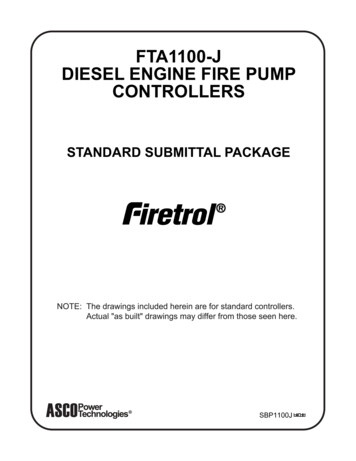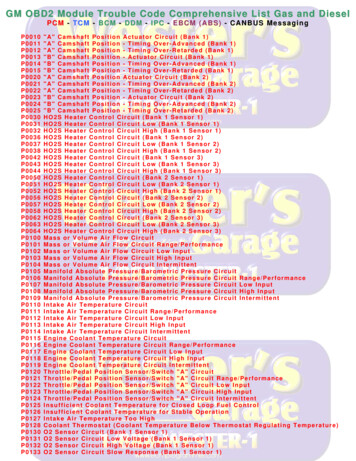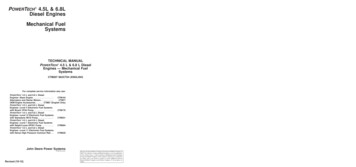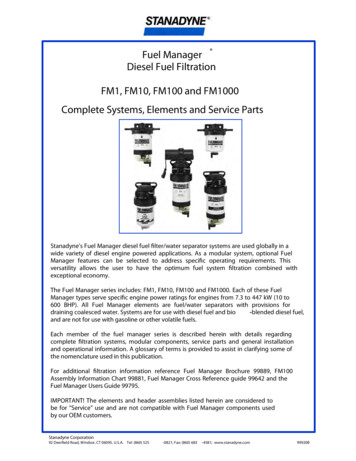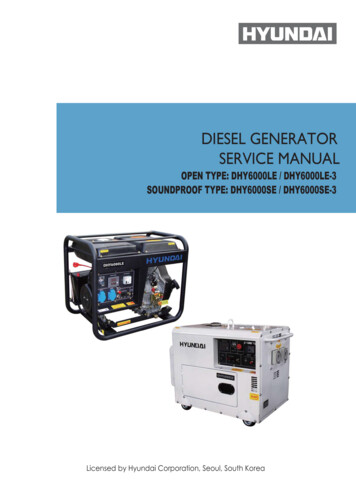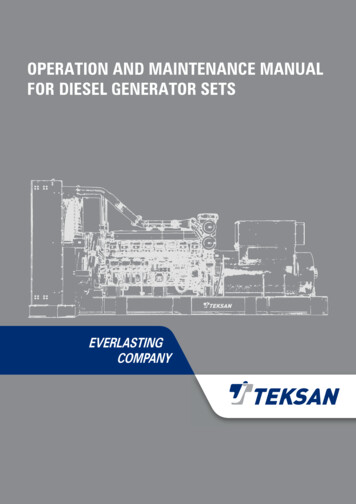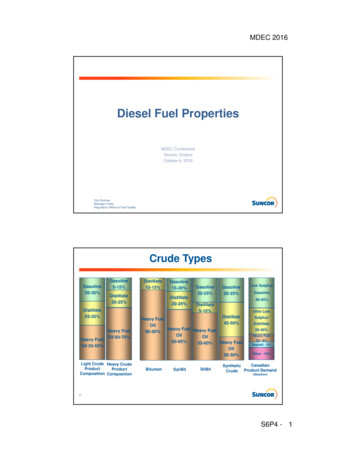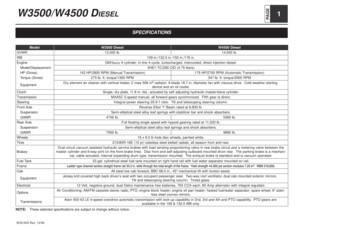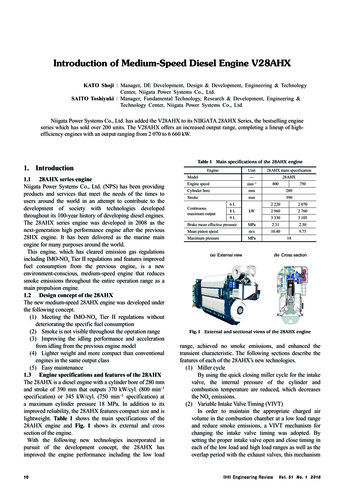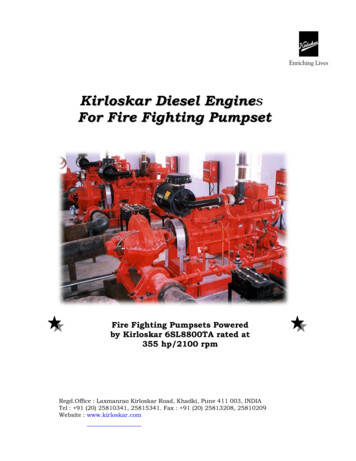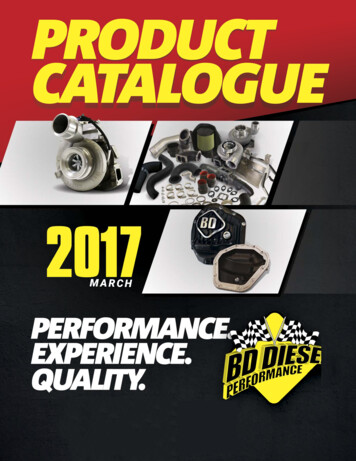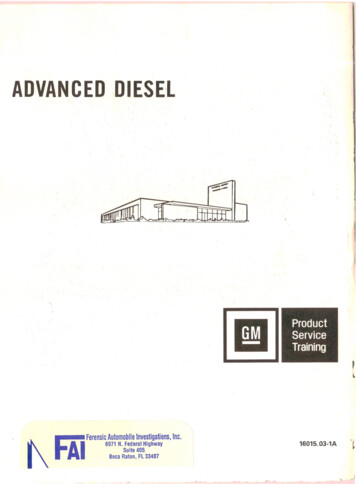
Transcription
ADVANCED DIESEL\IForensic Automobile Investigations, Inc.l\R56971 N. Federal HighwaySuite 405Boca Raton, FL 334871 6 015.0 3 -1 A
FOREWORDT his booklet is supplied by G M Product Service T rain in g to G M d ealer servicepersonnel upon th e ir co m p letio n o f th e subject course conducted at G MTrain ing Centers.W h ile this booklet w ill serve as an excellen t re vie w o f th e extensive pro g rampresented in the training cen ter session, it is not intended to substitute fo r thevarious service m an uals n o rm a lly used on the job. The range o f specifica tion s and variatio n in procedures b etw een carlines and m odels requires th a tthe division service publication s be referred to, as necessary, w h e n p e rfo rm ing these operations.Portions o f this m a n u a l w e re p ro d u ced using in fo rm a tio n p ro vid e d byS tanad yn e Inc., Diesel S ystem s G roup, m a n u fa ctu rer o f the Roosa M as te r In jection Pum p.All info rm atio n contained in this booklet is based on th e latest data availableat the tim e o f publication app ro val. The right is reserved to m ake product orpublication changes, at any tim e , w ith o u t notice. This booklet, or any portionth ereo f, m ay not be reproduced w ith o u t w ritte n consent o f G M Product S e rv ice T ra in in g , G eneral M oto rs C orp oratio n .
CONTENTSINTRODUCTION . IISECTION 1SECTION 2SECTION 3SECTION 4SECTION 5SECTION 6SECTION 7Diesel Fuel Properties. 1-1Fuel Tank, Filters, Lines and Fuel Pum p.2-1Roosa Master Injection Pum p. 3-1High Pressure Lines and Nozzles .4-1Rough Idle D iagnosis. 5-1Smoke D iagnosis. 6-1M.P.G. Diagnosis. 7-1
INTRODUCTIONThe intent o f this m anual is to study Diesel Fuel and itsm ajor pro p erties as well as each co m p o n en t o f theDiesel engine fuel system in sequence from the fueltank filler cap right through to the nozzles.The function o f each com ponent and its relation to adja cent com ponents as well as how each stage o f fuel pro cessing is dependent on the preceeding stage to operateproperly will be explained.This program includes injection pum p repairs w hich donot require test stand calibration as well as diagnosisstudies for rough idle, excessive sm oke and M .P.G.Diesel engine stresses are m ost critical and by nature,the diesel engine is less forgiving. Accordingly, qualityw orkm anship is m ost im portant w ith assem bly proce dures, torque specifications and cleanliness.
SECTION 1DIESEL FUEL PROPERTIESGENERAL DESCRIPTIONIt is very im portant for the Diesel Technician tounderstand various properties o f diesel fuel as they re late to vehicle design and engine perform ance. T he fol lowing will include an explanation o f the m ore criticalproperties as well as some o th er related facts.Diesel engines are the m ost efficient reciprocating,internal com bustion engines in use today. They are builtin a wide variety o f sizes and types for m any differentservices, ranging from the large, slow -speed engines forsh ip b o ard in stalla tio n to the relatively sm all, high speed, autom otive engines com m only used in trucks,buses, and small ships and boats.M echanically, diesel engines are quite sim ilar togasoline engines. H ow ever, there are som e significantdifferences:1. The diesel engine has a high com pression ratiocom pared to a gasoline engine.2. The diesel cylinder is charged only w ith air atthe beginning o f each cycle.3. The air is com pressed until very high pressuresand tem peratures are achieved.4. Fuel is sprayed into the hot, com pressed air nearthe end o f th e com pression stroke where it ignites spon taneously to produce power.The high com pression ratio o f the diesel engine andthe higher heating value o f diesel fuel accounts for itssuperior therm al efficiency o v er the gasoline engine.The N o. 2-D grade fuel is the one m ost generallyused for all m akes o f engines.The N o. 4-D grade fuel is designed for low- andm edium -speed engines operating under co n stan t speedand high load conditions. It is not intended for use in a u to m o tiv e diesel en g in es, and will n o t be d isc u sse dfurther.CRITICAL PROPERTIESWhile various diesel fuels contain num erous prop erties, only the more critical properties w hich affect en gine perform ance will be explained.Pour Point and Cloud PointPour point and cloud point determ ine th e m inim umam bient tem perature at w hich an engine can be o p eratedon a w axy distillate fuel w ithout the use o f auxiliaryheat.The pour point defines the tem perature at w hich thefuel stops flowing and cannot be pum ped.The cloud point defines the tem perature at w hichparafin w ax crystals separate from the fuel.# 2 D iesel fuel begins clouding approxim ately 2(Pam bient tem perature and com plete filter stoppage dueto parafin wax crystal separation will begin below ap proxim ately 10 am bient tem perature.B ecause the diesel engine burns liquid fuel, volatil ity is less significant in a diesel fuel than in a gasoline.Diesel engines can be operated on low volatility fuelsranging from kerosene to crude oil depending upon theengine design and the service in w hich it is used. Them odern high-speed, autom otive diesel engine, how ever,is usually operated on a middle distillate fuel o f carefullycontrolled physical and chem ical properties.W ithout the use o f an auxiliary heater, # 1 is rec om m ended where am bient tem peratures are anticip atedto be below 20 even though com plete stoppage occu rsbelow 10 . This will allow for sudden drops in te m p e ra tu re, w here wax crystals may form .M iddle distillate fuels are petroleum oils, heavierthan gasolines, w hich are obtained from fractional distil lation o f crude oils. Like gasolines, distillate fuels willnot burn unless they are m ixed w ith air in the properratios.S om e fillin g s ta tio n s p ro v id e “ w i n t e r i z e d ”“ clim atized” o r “ b lended” fuel w hich is a com binationo f # 1 -D and # 2 -D . The Blend will vary depending onthe am ounts blended and fuel w axing will be reducedproportionately.Diesel fuel com es in three grades suitable for vari ous types o f engines and operating conditions.T he N o. 1-D grade fuel is a kerosene-type designedessen tially to m eet the requirem ents o f th e G eneralM otors Series 71 engine in city bus service.# 1 Diesel F uel has sim ilar characteristics w ith theclouding process beginning approxim ately - 2 0 .NOTE: Some d ealer technical bulletins contain in form ation on blending unleaded gasoline w ith # 2 D ieselfuel to reduce fuel thickening and co nsequently , som eow ners are using this procedure. GM is no longer re c om m ending gasoline blending w ith diesel fuel and th e re fore discourages use of gasoline m ixtures. N e v e r usegasohol.
Heating ValueThe heat o f com bustion o f a diesel fuel, expressedin British therm al units (B tu ) p er pound o r per gallon, isa m easure o f the am ount of energy available to producew ork. In general, a diesel fuel having a higher volum et ric heating value (B tu per gallon) will produce morepow er o r provide b e tte r fuel econom y than a fuel oflow er heating value.t/ 0137,000141,0000.50.72.02.7I*oFUEL100 100 125 BTU/GALVISCOSCITY,CENTISTOKESFLASH POINTSince viscosity influences the size o f the fuel drop lets, it governs the degree of atom ination and p en etra tion o f the fuel spray. These are m ajor factors in obtain ing sufficient mixing o f fuel and air essential for propercom bustion. If the viscosity is too high, the fuel dropletswill be too large for proper mixing and poor com bustionwill result. Also, the droplets m ay strike the relativelycold cylinder wall and fail to burn. If the viscosity is toolow, the fuel spray will not travel across the com bustioncham ber and the poor mixing will result in im propercom bustion. Poor com bustion results in loss o f pow erand excessive exhaust sm oke.Flash PointFlash point does not affect engine perform ance. Itis specified because it relates to the hazards in handlingand storing diesel fuels, and governm ental agencieshave specified m inimum safe values. A low flash pointmay indicate contam ination with gasoline o r oth er morevolatile hydrocarbons.Cetane NumberFig. 1-1 Typical Fuel PropertiesFigure 1-1 shows that the heating value o f # 2 - D isconsiderably higher than # 1 -D and therefore, # 2 - D pro vides the highest efficiency and M.P.G. “ B lends” willreduce M .P.G. depending on the proportions used. Also# 1 -D is th in n er by weight (viscosity) and becom es lesscom pressable because o f certain clearances with thefuel injection pum p (w hich will be explained later).C onsidering the heating value and thinner weight sta rt ing the engine may require more cranking revs, bothcold and w arm . # 2 - D is recom m ended for best allaround perform ance and economy.O ccasionally, diesel fuel will be sold as hom e h eat ing oil from virtually the sam e pum p at the filling sta tion.U sually this fuel will be diesel fuel and is not homeheating oil. GM discourages use o f home heating oil indiesel vehicles.ViscosityViscosity is an im portant physical property o f adiesel fuel affecting injection pum p internal leakage andlubrication and injector lubrication and atom ization.The m inimum viscosity is limited by the need fora d e q u a te in je c to r and in jectio n pum p lu b ric a tio n .L o w er viscosity fuels are thinner and therefore willcause a higher rate o f internal pum p and injector leakageand injector dribblings which can lead to loss o f pow ero r sm oke problem s.W hen fuel is injected into the com bustion cham berof a diesel engine, ignition does not occur immediately.The interval betw een the beginning o f injection and igni tion of the fuel is called the ignition delay period o r lag.The duration of the delay period is a function o f enginedesign, operating conditions, and hydrocarbon com po sition o f the fuel.If the delay is too long, the engine may be hard tostart, and w hen the accum ulated fuel does ignite, therate of energy release is so great that it causes engineroughness or diesel knock. If the delay is short, com bus tion is even and the engine runs smoothly.The ignition quality o f diesel fuels is expressed interm s of cetane rating. A high cetane num ber indicatesgood ignition quality (sh o rt delay period), and a lowcetane n um ber indicates poor ignition quality (longdelay period).The cetane requirem ent of an engine depends uponengine design and operating conditions. C etan e re quirem ent increases as the com pression tem perature isreduced by such variables as low am bient tem p eratu res,low w ater jack e t tem perature, low com pression pres sure, or light load operation. A high cetane num ber isdesirable for low tem perature starting.B ecause this engine is equipped w ith glow plugs forcold starting aid, it is insensitive to cetane ratings.In high-speed engines, a high cetane num ber fuel isgenerally desirable to prevent engine roughness andknock. H ow ever, in engines sensitive to cetane number,a high cetane num ber fuel m ay cause black sm oke underhigh-load operation. The short delay causes raw fuel tobe sprayed into an established flame w hich producessoot. T hus, cetane requirem ent, like octane require m ent, cannot be sharply defined because o f the differ ences in engine design and operating condition. The
cetane num bers specified for diesel fuels are, therefore,a com prom ise to provide best overall perform ance for awide variety o f engines under varying operating condi tions.Additivesam ount has little harm in itself however, larger am ountscan be dam aging. N orm al engine operation will co n sum e small am ounts of w ater w ithout problem s. L argeram ounts and particularly w hen allowed to rem ain insidethe injection pum p for extended periods can create se vere corrosion dam age to the pum p and nozzles.M ost Diesel Fuel additives contain alcohol whichW ater content in storage tanks can also be a p ro b has proven harm ful to certain com ponents o f the Injec tion System and therefore, are not recom m ended. There lem w hen ideal conditions prevail for b ac te ria grow th.are, how ever, som e additives w hich are effective in re T he grow th tak es place at the fuel/w ater in terface.ducing the pour point of certain Diesel fuels. It has been Som etim es referred to as “ slim e” , “ D iesel g o o ” o rfound th at these depressants are not effective in all “ C ritters” . T hese m icroorganism s ap p ear as gelatinousm atter usually greenish black in color. W arm clim ates,diesel fuels and therefore are not universal.hum id conditions, w ater and extended storage periodsStarting Fluidsof stagnant fuel reserves give the b acteria tim e and u n U se o f starting fluids are absolutely not to be disturbed conditions in w hich to breed, if m oisture isused. To inject anything o th er than air through intake elim inated, grow th ca n ’t take place. O therw ise D ieselcan result in conditions such as hydro-static seizure, Fuel can be chem ically treated w ith biocide to retardbroken pistons, bent o r broken connecting rods, broken growth.starter o r flywheel ring gear teeth etc. F or exam ple, upW hen “ D iesel goo” gets into the fuel system , eachto a 50% overload can be obtained by injecting eth ercompo n en t o f the fuel sy stem m ust be c lea n ed asinto the air intake.thoroughly as possible and m ust be treated w ith biocideContaminationas this fungus is nearly im possible to destroy com pletelyBy law .05% (Vi o f 1% ) o f w ater sedim ent by vol w ithout this chem ical. B iocides
Portions of this manual were produced using information provided by Stanadyne Inc., Diesel Systems Group, manufacturer of the Roosa Master In jection Pump. All information contained in this booklet is based on the latest data available at the time of
